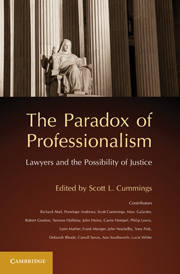Book contents
- Frontmatter
- Contents
- List of Tables and Figures
- Contributors
- Preface and Acknowledgments
- 1 Introduction
- PART I LAWYERS AND THE PUBLIC GOOD: THE FUNDAMENTAL DILEMMA
- 2 Are Lawyers Friends of Democracy?
- 3 “The Conscience of Society?”
- 4 More Lawyers than People
- 5 Faces of the Tort Pyramid
- PART II LAWYERS AND THEIR CLIENTS: DETERMINANTS OF ETHICAL PRACTICE
- PART III LAWYERS AND SOCIAL CHANGE: MOBILIZING LAW FOR JUSTICE
- 14 Epilogue
- Index
- References
5 - Faces of the Tort Pyramid
Compensation, Regulation, and the Profession
Published online by Cambridge University Press: 05 June 2012
- Frontmatter
- Contents
- List of Tables and Figures
- Contributors
- Preface and Acknowledgments
- 1 Introduction
- PART I LAWYERS AND THE PUBLIC GOOD: THE FUNDAMENTAL DILEMMA
- 2 Are Lawyers Friends of Democracy?
- 3 “The Conscience of Society?”
- 4 More Lawyers than People
- 5 Faces of the Tort Pyramid
- PART II LAWYERS AND THEIR CLIENTS: DETERMINANTS OF ETHICAL PRACTICE
- PART III LAWYERS AND SOCIAL CHANGE: MOBILIZING LAW FOR JUSTICE
- 14 Epilogue
- Index
- References
Summary
INTRODUCTION
To what extent does the efficacy of the tort system depend on the plaintiff's tort bar? In this chapter, I address how the regulatory function of the tort system is skewed by structural features of the legal profession.
The tort system serves at least two separate functions. First, it provides for compensation for a limited class of injured persons. Second, it serves to regulate safety. In addition to these two functions, the tort system reflects a particular moral view of responsibility for injury. For any of these roles to be served, the tort system requires significant lawyer energy. Although it is possible for nonrepresented plaintiffs to file suit, in fact most people do not sue without the aid of a lawyer. More to the point, few unrepresented plaintiffs are ever successful.
In this chapter, I ask how well the twin functions, as well as the moral sensibility, are served by looking at the role of lawyers in the tort system. My conclusion is that, on account of the peculiar way in which the legal profession intersects with the tort system, this system cannot adequately serve the functions presently assigned it. Before assessing the role of lawyers, it will be helpful to describe in general terms the compensatory function and the regulatory function of the present tort system.
- Type
- Chapter
- Information
- The Paradox of ProfessionalismLawyers and the Possibility of Justice, pp. 90 - 106Publisher: Cambridge University PressPrint publication year: 2011



